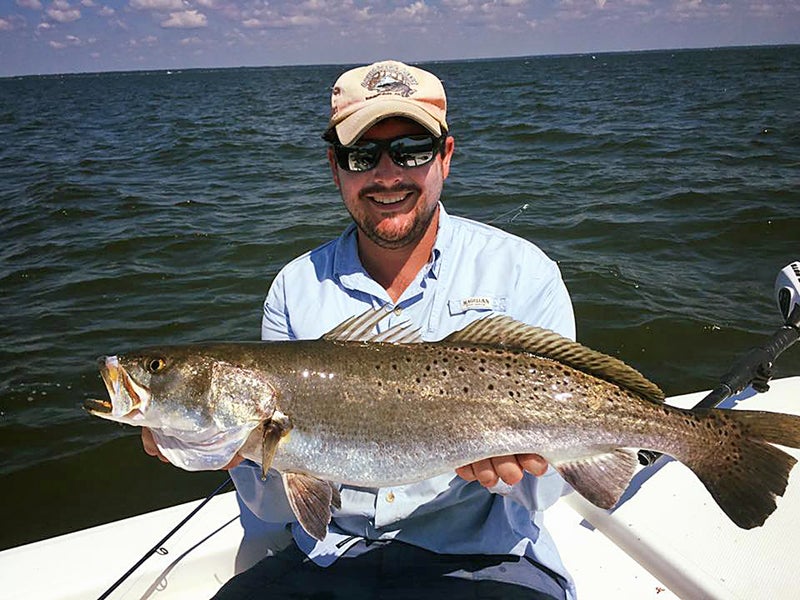String’s philosophy as a guide is to help his clients land a nice box of trout and then start looking for big fish. When a big sow trout is caught, he tries his best to convince his clients to take pictures and then carefully release the fish.
“It’s a lot of fun catching 14- to 18-inch fish on topwaters, Mirrodines and grubs,” he said. “Then we’ll go look for big fish. It’s been good for the last two months. We’ve caught a lot of big fish on the beach at Fort Morgan, Sand Island and Dauphin Island. Now they’re moving up the bay.”
Chris Blankenship, Director of the Alabama Marine Resources Division, echoed String’s assessment of the trout fishing and added that other anglers are adopting the catch-and-release philosophy for large trout.
“Speckled trout fishing has been very good in Mobile Bay and Mississippi Sound this spring,” Blankenship said. “A few people I have talked to have not had as much luck in the Perdido Bay system. All the flood waters we had in the Delta over the winter and early spring really moved the fish down the Bay this year. That set up for some great fishing on the flats and beaches early in the day. Now that the water and weather has warmed, the fish are moving into the usual deeper water during the day pattern.
“A lot of people have set a maximum size limit on their own. Many guides are not letting people keep specks over 20 inches. This allows the larger females to continue to spawn.”
String said when the weather gets hot in late June, July and August, he takes advantage of the time slot when most anglers are not on the water.
“When it gets hot, I catch a lot of fish between 10 and 2,” he said. “I can deal with the heat because I catch a lot of fish when everybody else has gone to the house. If you’re willing to endure the heat, you can go out there and crush them at places like Zundel’s, Klondike or Fish River Reef.”
String said Mirrodines, topwater plugs or soft plastics have produced plenty of fish from the petroleum rigs in Mobile Bay to the shallow water of the Eastern Shore.
“I love throwing artificial baits, but when it comes to really big fish, you’ve got to feed them something big that looks really natural,” he said. “I occasionally catch a big one on topwater, but it’s usually a big menhaden.”
String also uses live croakers and finger mullet up to 5-6 inches. He trims the tails on the finger mullet so they can’t swim so fast.
One thing about fishing with live bait, however, is you must keep an eye out for terns diving on the bait, according to String.
“You’ve got to be watching about 40 feet in the air,” he said. “If you see the tern coming for your bait, you’ve got to yank the line to keep the tern from getting it. And I’ve had trout blow up on the bait as I was trying to keep it away from a tern. The other day, the terns hit the water about eight times trying to get the bait. It was like using a popping cork. I ended up catching the trout, about a 3-pounder.”
String has some more good news. The flounder fishing, which had suffered more than the trout fishing, appears to be on the rebound as well.
“On the beach, I know a lot of guys have been catching a lot of flounder,” he said. “I haven’t started fishing for them, but I’m planning to get some bull minnows and check the different spots like the Grand Hotel. I’ve talked to a lot of people who said it’s coming back. Hopefully, we’ll get a good run of flounder up the bay. That’s something we haven’t had in a few years, either.”
PHOTOS: Evan Wheeler boated this huge speckled trout estimated at 8-plus pounds while fishing with Tim String in Mobile Bay. String took a photo and Wheeler quickly released the fish. String (bottom photo) has taken advantage of the great trout fishing in and around Mobile Bay this year.








